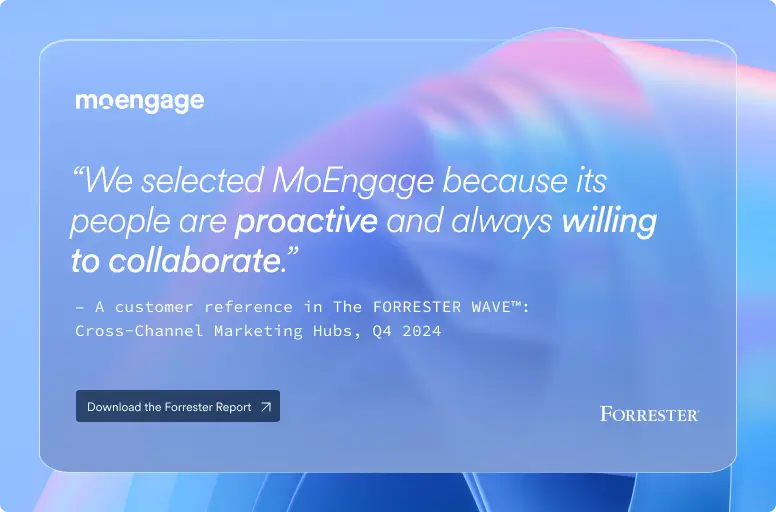🔥 [Panel] Personalization, AI, Trust—What Top BFSI Marketers Are Doing Differently.
Register Now
The banking industry offers several different kinds of services to its clients. The majority of the banks follow traditional practices while providing services. But recently, with technological advancements, the concept of digital banking has come to the forefront and has gained immense impetus the world over. Now, people have complete access to digital banking platforms. They can do everything from opening an account to depositing money, from applying for loans to paying their credit card bills, and from share trading to paying taxes in a single click right from the comfort of their home. In other words, the digitisation of the banking sector has made banking much simpler and faster for people.
But, when we speak of the digital revolution in the banking sector, it is also vital to anticipate customers’ growing needs concerning their finances. It has become crucial for banks to identify effective ways and means to market their services so that their customers remain engaged and loyal to them for a long time, thanks to the enormous competition out there.
Jayanth Ananthakrishnan, VP, Product & Engagement at Mashreq Neo, in conversation with Ashwin SL, Head of Marketing at Mashreq, beautifully unravels his knowledge and experiences in customer engagement and marketing, which are covered in this article.
Considering Mashreq’s two fronts, Mashreq Bank and the more recent Mashreq Neo, it is interesting to note that although both offer banking solutions, the former is an old-school, traditional bank. At the same time, the latter is its new-age, digital avatar.
Mashreq Bank (formerly Bank of Oman) was founded in 1967 and is one of the oldest private banks in the UAE. Interestingly, it is credited with many firsts. It was the first bank to launch an ATM in the UAE, debit & credit cards, loan facility in the UAE, etc. So, right from its inception, the bank has been at the forefront with its innovative banking solutions.
In an effort to take banking to people rather than getting people to banks, they launched Mashreq Neo in 2017. The year was also significant as it marked the bank’s 50th anniversary, so there couldn’t have been a better occasion to take a big leap forward and go digital.
Mashreq Neo is a full-fledged online banking service that caters to all financial needs of its customers and has a straightforward user interface that appeals to all age groups. It is also available in the form of a mobile app. Interestingly, since its launch, Mashreq Neo has seen four times the number of customers compared to Mashreq Bank, which relies on traditional marketing channels.
It is a common misconception that digital banking is specially designed for millennials who want everything to happen quickly and easily. However, with respect to Mashreq Neo, Ananthakrishnan stresses that this notion is not entirely true. He says that using Mashreq Neo is no rocket science; it can be used by anyone with a fair knowledge of using a mobile phone. Simplicity and ease of use are the keys on which most digital banking platforms these days are based.
The basic challenge for Mashreq Neo while planning the entire user journey was to identify the basic customer pain points. For instance, reading analytics data regarding customer dropout rate was important as it could help them identify customer needs and demands. The less complicated the process, the simpler it is to boost conversions.
The biggest problem for any digital banking platform is getting new customers. A few steps need to be taken for activating an account once it is opened, be it online or physically in the bank. However, online transacting for newbies can be difficult to understand. Therefore, banks must design a simple step-by-step transacting process. For instance, once a new customer is onboarded, instead of making a deposit or transaction, Mashreq Neo simply says, “activate your debit card”, which is much easier for users to understand and the most obvious step to begin the journey as well.
Ananthakrishnan states that users become profitable to the bank only when they start transacting through the platform. Therefore, it is vital to make the customer do his/her first transaction. After that, sending pop-ups and smart messages to customers are the marketing strategies, which banks generally apply. However, it is important to know how much marketing is too much marketing. No particular number of emails or notifications is appropriate; one has to gauge its user base and then decide the right number. Overdoing is always bad!
“Olympics Bounce” is an interesting phenomenon in which there is a spiked interest in sports events and material for up to three months after the Olympics. After that, the interest gradually plateaus. The speaker quotes this phenomenon and says that similar trends can also be seen in customer behaviour in digital banking. For instance, if an online bank launches a campaign offering prizes and benefits to customers for booking a deposit, there may be a significant rise in the number of deposits booked for the first couple of months after the campaign launch. But as time passes, the numbers seem to plateau, and online banks have to devise new strategies and launch new campaigns to keep the customers engaged. So, customer engagement and marketing are a continuous and ongoing process for digital banking platforms and have a lot of scope for review and innovation.
Be the first to access actionable reports, guides, tips, videos, podcasts from experts in Customer Engagement, retention and more!





MoEngage is an insights-led platform trusted by 1,350+ global brands like McAfee, Flipkart, Domino’s, Nestle, Deutsche Telekom, and more. MoEngage’s powerful analytics, personalization, and AI capabilities give a 360-degree view of your customers and help you create journeys across digital channels.
© Copyright 2025 MoEngage. All Rights Reserved.

Please wait while you are redirected to the right page...
